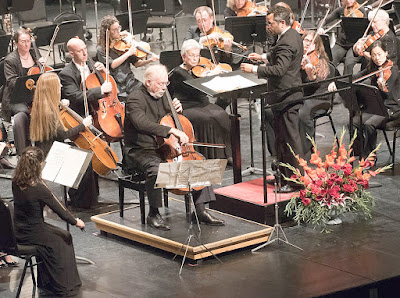All afternoon Sunday, the ECC Arts Center was humming with activity. The Elgin Youth Symphony Orchestra (EYSO) held an open house in conjunction with recitals by its Chamber Music Institute ensembles. The ECC Musical Theatre was holding dance auditions for their summer production of American Idiot. And the Elgin Master Chorale (EMC), the Elgin Symphony Orchestra (ESO) and the EMC Children's Chorus combined for a concert in Blizzard Theatre.
It was a striking example of the depth of local participation in the Arts, as musicians of all ages toted in instruments, formally-dressed singers hurried backstage and patrons lined up for tickets and lingered by an exhibit of the history of Elgin's premier choir.
The main event was the reprise of Johannes Brahms' Ein deutsches Requiem ("A German Requiem"), marking seventy years since the Elgin Master Chorale was formed as the Elgin Choral Union, consisting of singers from local church choirs. The Choral Union's first performance in 1947 was Brahms' Requiem.
Welcoming remarks by EMC member Amy Cho struck the right note of informality in acknowledging Stu Ainsworth, perennial friend of the Arts and the event's key sponsor, and Ann Chipman, daughter of the EMC's founder, Dean Chipman. She also introduced the first act, the EMC Children's Chorus.
 |
| The Elgin Master Chorale Children's Chorus, conducted by Rebecca Narofsky. |
They sounded like the Von Trapp singers in their renditions of five German songs (by Brahms) to open the program. Their 35-minute set included thirteen songs in all, displaying a wide range of technical skill in covering spirituals, theatrical scores and world music. Conductor Rebecca Narofsky has expanded their repertoire impressively in a short time and their discipline shows. Sharing the stage with the EMC and the ESO is a valuable experience for these young singers, and their co-appearances should help expand the audience.
More than 150 artists assembled after intermission for the German Requiem: nearly 100 singers arranged on risers in back of a 69-piece orchestra. So large was the combined ensemble that much of the audience was situated closer to the conductor than the choir.
Brahms' seven movements were assembled over a period of several years, as detailed in the excellent program notes, and their effects are different. The music excelled in the sixth movement with its programmatic drama, and especially the fifth, which featured the choir's exquisite soft background harmonies.
 |
| The Elgin Master Chorale performs Brahms' A German Requiem with the Elgin Symphony Orchestra, conducted by EMC Music Director Andrew Lewis. |
Careful preparation was apparent in the Chorale's mastery of dynamics and articulation, and the German lyrics were rarely hard to follow by carefully reading in the printed program. The accompaniment included many ESO guest musicians, whose work generally defied criticism. Bass-baritone David Govertsen and soprano Henriët Fourie Thompson gave praiseworthy solos that emphasized tone and technique in the chromatic melodies of Brahms' Romantic style.
 |
| Bass-baritone David Govertsen and Soprano Henriët Fourie Thompson. |
EMC Music Director Andrew Lewis maintained confident control of his massive array of forces for the nearly 75 minutes of continuous music. The volume of sound was enormous at forte and above, and the spatially expansive vocals lent an atmospheric quality to the divine lyrics and metaphysical subject matter. Funerals are filled with complex emotions and contemplations of eternity, and there was far more joy than sadness in this performance.
In the Arts, the difference between amateur and professional can be hard to define. It's not necessarily a matter of excellence or even whether a fee is involved. The willingness of Elgin artists to work together under all sorts of arrangements, regardless of their status, means audiences can experience the finest theatre, music, visual and literary arts in a local venue for relatively little cost. Always among the best examples is this pairing of the Elgin Master Chorale and the Elgin Symphony Orchestra, whose concerts are not just amazing in their audacity of scale but also highly successful as art.
Hear the EMC and ESO join forces again May 6-7 at the Hemmens Cultural Center in Elgin, where they present Vaughn Williams' Serenade to Music as part of the "Voices of Spring" festival. For more information, go to www.elginsymphony.org or www.elginmasterchorale.org.








